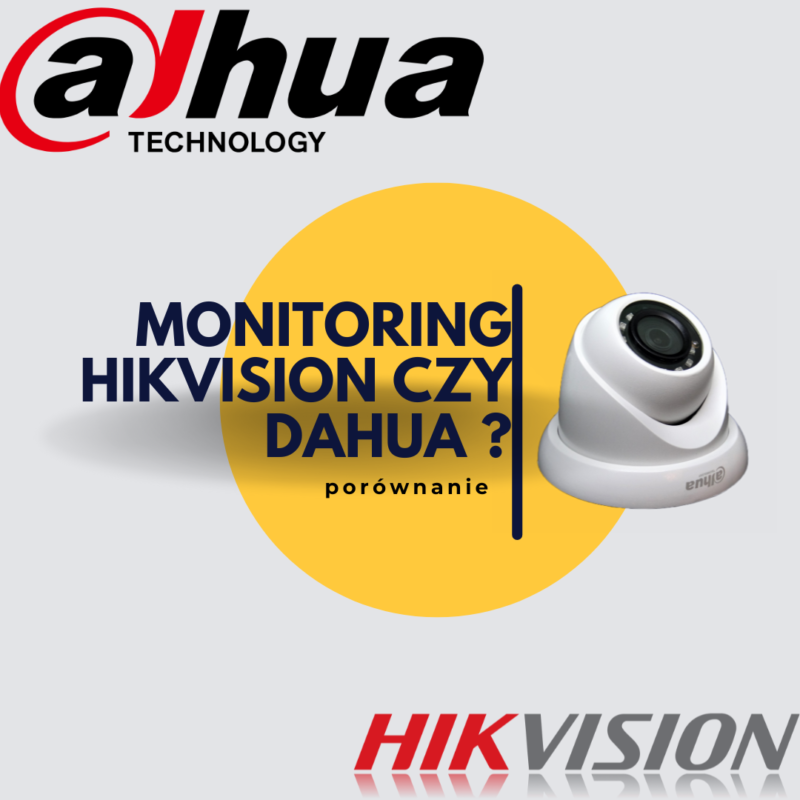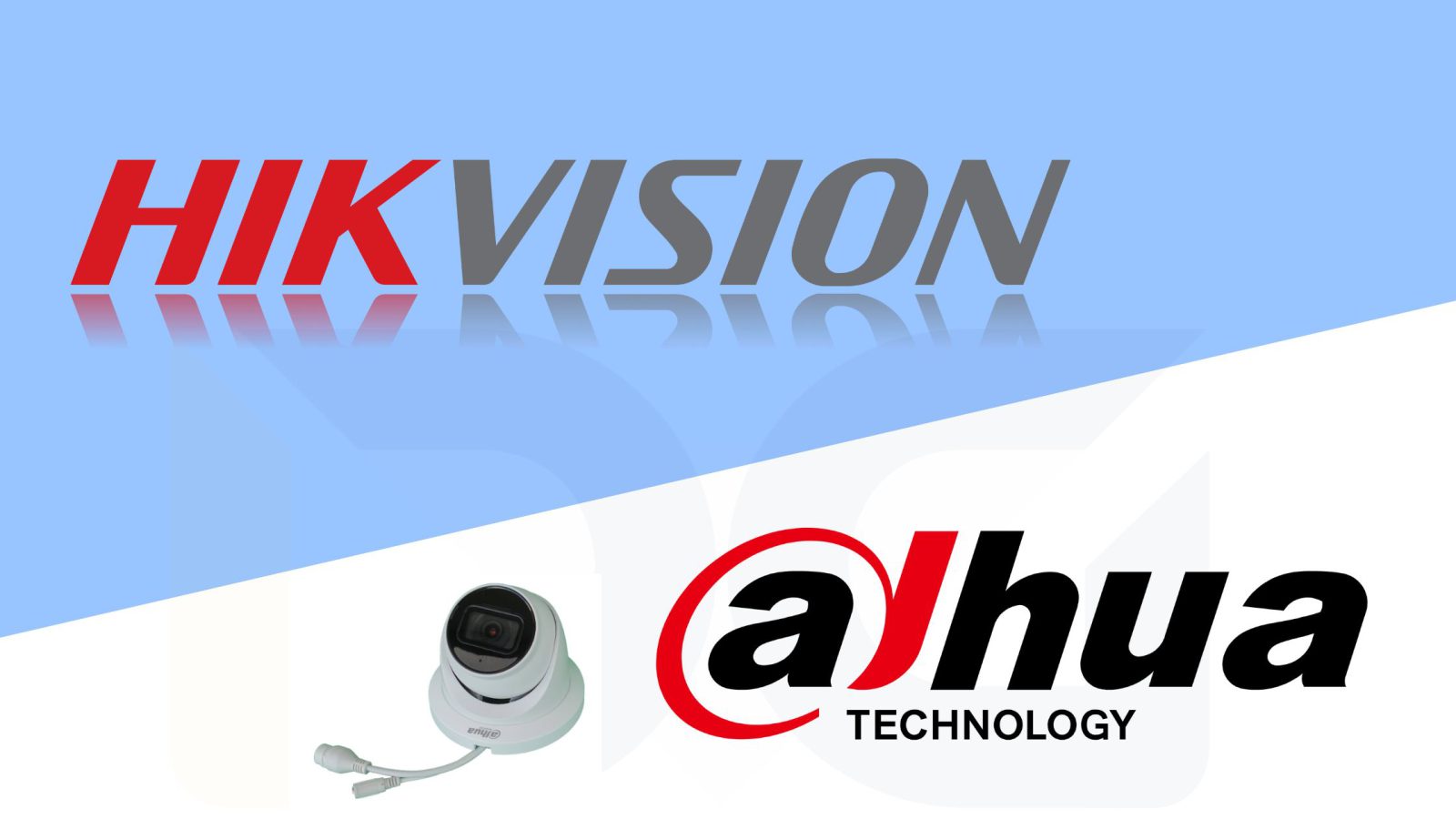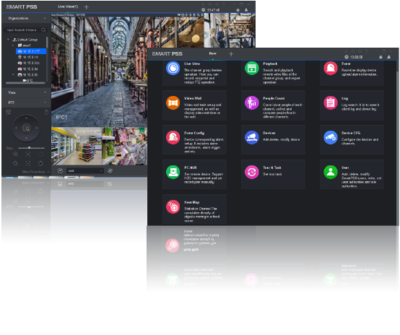
Hikvision vs. Dahua Monitoring: Which One is Better?
Choosing a brand for CCTV surveillance can be a challenging task, as there are many companies in the monitoring industry. Hikvision and Dahua are the two most popular brands in the Polish market, representing similar levels of technology and pricing. In this blog post, we will compare these two brands and help you decide which one is right for your needs.
Hikvision:
Hangzhou Hikvision Digital Technology Co., known as Hikvision, is the most popular manufacturer of security cameras and IP monitoring. What makes them great? Their diverse range of available security cameras, recorders, and related products. As a result, Hikvision produces excellent IP surveillance cameras that are both user-friendly and highly efficient. They are also one of the well-known options in this space. Furthermore, Hikvision monitoring products are known for being much easier to install than products from other brands. Their camera systems offer many features that not only focus on ease of use and integration but also on capabilities and performance.
Hikvision is a global leader in innovative vision monitoring products and solutions. The company offers a comprehensive line of products and services, from cameras and recorders to software and accessories. Hikvision places a strong emphasis on research and development and constantly introduces new, innovative products to the market.
Dahua:
Zhejiang Dahua Technology, abbreviated as Dahua, is another leading player in the vision monitoring industry, offering a wide range of products and solutions. The company is known for its reliability and places a strong emphasis on customer support.
In 2021, Dahua was one of the world’s most popular manufacturers of monitoring cameras, recorders, and related goods. The company stands out as the third-largest manufacturer of video surveillance systems globally in terms of market share.
Due to the technological level, it is divided into three different types of CCTV cameras:
- UltraSeries
- ProSeries
- LightSeries
The company offers three different types of security cameras: LightSeries, ProSeries, and UltraSeries. These names indicate the quality level of the cameras, with LightSeries being the most basic model, ProSeries in the mid-range, and UltraSeries being the best equipment the company has to offer. Locally, larger companies and enterprises tend to use UltraSeries cameras, while small businesses and homes prefer LightSeries models. ProSeries falls somewhere in between, representing a very high level as well.
Open this in UX Builder to add and edit content
Dahua is known for two things: digital video recorders (DVRs) and analog video recorders. Their NVR (Network Video Recorder) products meet high expectations with a 4K quality graphics processor capable of achieving a maximum refresh rate of 60 frames per second. Additionally, Dahua NVRs are equipped with ePoE (extended Power over Ethernet) technology, making them highly sought-after security cameras in the market. ePoE technology is an extended version of the standard PoE (Power over Ethernet), allowing data transmission up to a distance of 300 meters at a speed of 100 Mbps and up to 800 meters at a speed of 10 Mbps to compatible devices.
So, which brand is better – Dahua or Hikvision? Let’s take a closer look at each company to see how they stack up.

Hikvision Recorders VS Dahua Recorders
Hikvision and Dahua offer a wide range of recorders, from entry-level models to high-level ones. Both brands provide features such as remote viewing, motion detection, email and push notifications. However, there are some key differences between these two brands.
The Hikvision DS-7616NI-K2 is a modern, 16-channel IP surveillance recorder that captures high-resolution images from cameras. The device is equipped with independent HDMI (4K resolution) and VGA (up to 1080p) outputs, allowing for the connection of two monitors simultaneously. The recorder also allows for full configuration of the image on each output, including window divisions and the display of footage from any camera. It has two ports for connecting SATA hard drives with a maximum capacity of 10 TB. The equipment also supports network-attached storage (NAS)/IP SAN disk arrays.
Key features of the Hikvision DS-7616NI-K2 include:
- Recording high-resolution images (up to 8 MP)
- Independent HDMI (4K/30 Hz, 2K, 1080p/30/60 Hz) and VGA (1080p/60 Hz) outputs
- Support for up to 16 Hikvision IP cameras or other models supported by ONVIF
- Maximum bit rate: 160 Mbps (input), 160 Mbps (recording), 160 Mbps (output)
- Support for 2 SATA hard drives with a maximum capacity of 10 TB
- VCA (Video Content Analysis) image analysis (virtual line crossing, face detection, intrusion area)
- AcuSense support
- ANR (Automatic Network Replenishment) support
- Compression formats: H.265+/H.265/H.264+/H.264/MPEG4
- USB 2.0 (1x) and 3.0 (1x) inputs
- Audio input and output
- 4/1 alarm input and output
- Efficient monitoring of LAN network status, disks, and cameras
- Low-bandwidth display of footage from all cameras (channel 0)
The Dahua NVR4216-4KS2/L is a 16-channel IP recorder with a resolution of up to 4K (8 MP), capable of recording footage from IP cameras. With a bit rate of 160 Mbps, the device can handle high-resolution cameras. It supports archiving video material generated by the device on two hard drives with a capacity of up to 10 TB. The image can be displayed via parallel HDMI/VGA ports (showing the same image).
Key features of the Dahua NVR4216-4KS2/L include:
- Video inputs: 16x IP channels
- Video outputs: 1x VGA, 1x HDMI (4K UHD)
- Maximum recording resolution: 3840×2160 (8 MP)
- Maximum bit rate: 160 Mbps (input), 160 Mbps (recording), 64 Mbps (output)
- Compression formats: H.265+/H.265/H.264+/H.264/MJPEG
- Audio inputs/outputs: 1/1 (RCA)
- Alarm inputs/outputs: 4/2
- Network interface: 1x Ethernet RJ45 10/100/1000 Mbps
- Disk support: 2x SATA III HDD (maximum 20 TB)
- Support for cameras with IVS (Intelligent Video System) image analytics or thermal mapping
- SMD+ (Smart Motion Detection Plus) analysis
- Local playback of up to 8 channels (2 channels at 8 MP or 8 channels at 2 MP)
- Sound recording from 16 IP cameras
- Window division options: 1/4/8/9/16
- Compatibility with ONVIF, RTSP, SDK, CGI connections
- P2P connection support
These two recorders are direct competitors, and their specifications are very similar.
The Hikvision recorder has an advantage in outgoing bitrate, which can be important when using high-resolution cameras in busy areas due to the compression characteristics of H.264. The Hikvision recorder also performs better in displaying images on a monitor, as it allows for independent configuration of the VGA output compared to HDMI. The other parameters are almost identical. This may indicate that Dahua is quickly catching up, but the Hikvision recorder appears to be a more flexible solution with slightly better parameters. Hikvision’s software is also considered to be more intuitive.
Hikvision or Dahua Cameras
Both Hikvision and Dahua offer a wide range of cameras, from basic models to higher-end ones. Both brands provide features such as night vision, wide dynamic range, and remote viewing. However, there are some key differences between these two brands. Hikvision cameras are usually more expensive than Dahua cameras and are more commonly used in large-scale projects. They also offer more features and better quality. Dahua surveillance cameras are a good choice for budget-conscious individuals but may not offer as many features as Hikvision cameras.
The camera presented below can be a compelling alternative that competes seamlessly with Hikvision solutions.
IP CAMERA TIOC 2.0 DAHUA IPC-HDW3849H-AS-PV-0280B-S3
TiOC, TiOC Camera is an innovative solution that integrates 24/7 full-color monitoring, active deterrence, and artificial intelligence. It accurately identifies potential threats and effectively warns intruders, ensuring the protection of lives and property.
Full-color monitoring 24/7
Low-light performance:
- Enables capturing color footage and capturing vivid details in low-light situations.
- Increases the likelihood of gathering relevant information about people, vehicles, and events through brighter monitoring.
Excellent video quality in darkness
- Prevents rain reflections and does not attract insects.
- Supports integration with a DVR recorder for AI search capability. False alarms are filtered out, allowing human and vehicle classification to focus only on their intended targets.
With the use of red-blue flashing lights and a 110 dB siren, the camera can actively warn intruders before users become aware of the event.
The WizSense series of products and AI solutions utilize an autonomous AI chipset and deep learning algorithm to accurately recognize people and vehicles in images. This allows users to focus on real targets.
WizSense is easy to set up, especially with SMD 3.0, which can be activated with a single button. This simplifies daily operations for customers and enables them to make smart business decisions.
The SMD motion detection system is able to distinguish between people and vehicles in a given scene, sending precise alarms that help secure your business or home.
The system compares captured facial features with those stored in the database. If a match occurs, the system will perform a pre-set action.
Perimeter protection is an alarm system that activates when someone or something crosses a designated line or enters a restricted area.
Active defense – with its built-in spotlight and audible alarm, it can actively warn intruders and inform the user.
AI Coding ensures the highest image quality while reducing bandwidth and storage requirements by 50%.
Facial features captured by the camera will be compared with facial data in an existing database. If there is a match, the system will respond with pre-registered alarm actions.
CAMERA IP HIKVISION DS-2CD2T86G2-ISU/SL(2.8mm)(C)
Both Hikvision and Dahua offer a wide range of cameras, from basic models to high-end ones. Both brands provide features such as night vision, wide dynamic range, and remote viewing. However, there are some key differences between these two brands. Hikvision cameras are usually more expensive than Dahua cameras and are more commonly used in large projects, but they also offer more features and better quality. Dahua surveillance cameras are a good choice for budget-conscious individuals but do not offer as many features as Hikvision cameras.
The camera you mentioned, HikVision DS-2CD2T86G2-ISU/SL, is powered by Darkfighter technology for excellent sensitivity in low-light conditions and features AcuSense technology for more accurate filtering of false alarms. It also comes with a built-in speaker and strobe light that can effectively be used for deterrence.
AcuSense series cameras from Dahua utilize advanced deep learning technology to detect human and vehicle silhouettes and filter out alarms that are not related to humans or vehicles. These cameras also have the ability to save snapshots of identified objects from a large dataset, making it easier for later search.
The 1/1.8-inch CMOS sensor and 2.8mm fixed focal length lens used in the camera provide a wide viewing angle of approximately 111° horizontally, allowing for a greater coverage of the surroundings.
Hikvision cameras with AcuSense technology use artificial intelligence-based technology to achieve more accurate object classification and minimize false alarms. The machine learning technology used in these devices enables better classification of recognized objects.
The iR illuminators in the camera are made with EXIR technology, providing more even illumination of the scene, resulting in better visibility of details in the recorded image under low-light conditions.
The DS-2CD2T86G2-ISU/SL camera has a built-in strobe light that is triggered upon detecting an intruder, which, combined with the message from the built-in speaker, can effectively deter intruders in the protected area.
Although the IP cameras from both brands are comparable, they differ in certain parameters. For example, Hikvision has a higher maximum bitrate for IP cameras, which directly affects the quality of the video stream. However, in most cases, cameras rarely utilize their maximum bitrate, so this parameter will only be significant in specific cases. On the other hand, in the mentioned comparison, the sensor size of Hikvision is larger, but Dahua’s camera lens has significantly better light performance, enabling Dahua to achieve better results in terms of seeing farther and capturing more details in low-light conditions.
The Hikvision camera boasts a wider viewing angle of 111 degrees compared to Dahua’s 106 degrees. Both cameras are equipped with active deterrence features. Dahua alternates flashing red and blue lights and generates a sound alarm, pre-recorded messages in English, or a custom message that can be recorded using a smartphone. In the case of Hikvision, it uses a strobe effect with white light and a voice message.
So, which one is better – Dahua or Hikvision? Both brands offer a wide range of products and solutions, from entry-level to high-end. However, the choice will often depend on the specific application and operating conditions of the camera.
Functionalities and Software: Hikvision or Dahua
Dahua’s Smart PSS (Professional Surveillance System) application is designed to manage various surveillance devices, including analog and network video recorders, IP megapixel cameras, IP video intercom devices, SVR storage devices, and video decoders. The application facilitates device management and usage through its built-in interface. It supports up to 2000 connections and allows for quick setup of remote access to the recorder, providing the ability to view live camera feeds and change settings. The SmartPSS software is available in several languages, including Polish. Due to its adaptability and user-friendly interface, Dahua’s software is commonly used in small and medium-sized surveillance projects.
On the other hand, iVMS-4200 software from Hikvision is designed for video management and offers a wide range of features. It can be used for small or large-scale surveillance projects. With this software, a hybrid system can be created that combines network and up to 256 devices on four screens, allowing for displaying images from up to 64 cameras on a single monitor. The software also enables remote playback of recordings, the use of special e-maps for visual monitoring, display of alarm messages, and two-way audio transmission.
Both software solutions have similar functionalities, and each has advanced versions available for purchase. Hikvision’s advanced version is iVMS-5200, while Dahua’s is an extended license for SmartPSS.
Hikvision and Dahua are relatively similar when it comes to software, and each provides software for video management and configuration. As mentioned, Hikvision particularly excels in integrating its products, giving them an advantage in both single-brand security camera systems and systems from other brands. The IP cameras from both manufacturers can support features such as alarm integration, facial recognition, motion detection, reduced false alarms, and video material settings management.
One noticeable difference between Hikvision and Dahua is the detection of unusual behaviors and environments. Hikvision has developed software for its IP security cameras that can focus on and recognize faces when connected to a database for informational purposes. Additionally, with the help of artificial intelligence, it can detect unusual aspects in any environment, such as dropped or left-behind items. This provides an advantage to Hikvision, which focuses more on software feature development.
At the time of writing, Dahua has reduced the number of unique video streams to two, while Hikvision has the capability to produce three. This means that each video stream can have a different resolution from the others if you choose to use more than one stream.
Both manufacturers include a feature called Channel Zero in their software. This feature provides security camera system owners with one screen for previewing all channels on a device. Additional features of Channel Zero, according to a related article, include:
- Reduced bandwidth while maintaining quality
- Optimized personal and remote viewing
- Enhanced surveillance capabilities
Although seemingly simple, Channel Zero enhances the security camera system across the board.

Wireless Monitoring: Hikvision or Dahua
Hikvision’s wireless monitoring kit is straightforward to install, requiring only basic technical knowledge for mounting. The recorder comes with a plug-and-play feature, and when the cameras are connected to power, it automatically assigns IP addresses to them. While the cameras are easy to install, they come with advanced features. The downside of this kit is the limited range of up to 15m, which may require the use of a WiFi repeater. Configuring such a solution is more challenging.
Hikvision Wi-Fi Kit includes:
- DS-7104NI-K1WM recorder with 4 channels
- 4 Wi-Fi IPC-B2W-K cameras with 2MP resolution, built-in microphone, and 1TB HDD
- OSD menu available in Polish language
- WPA WiFi encryption
- Network interface: 1 x Ethernet 10/100 Base-T (RJ-45)
- P2P support (cloud) for remote access without port forwarding and public IP address
- Compatible with Android, iOS, and IE browser for mobile devices
- Built-in web server, support for CMS or mobile client
Dahua has been replacing its wireless surveillance cameras with the IMOU series of devices, produced under the IMOU brand. Therefore, the availability of Dahua WiFi cameras is limited. Instead, Dahua offers simple IMOU cameras and recorders as a cost-effective and easy-to-install alternative for self-installed surveillance.
IMOU Wireless Kit from Dahua:
- The IMOU Wi-Fi Kit/NVR1104HS includes everything needed for a DIY installation. It comes with four IP IMOU BULLET 2C 2MP cameras and the iMOU-W100 recorder with a 1TB HDD, which allows remote control and viewing of the camera’s live feed. The iMOU-W200 model is the same as iMOU-W100 but offers eight channels. The recorders work with the IMOU Life app for Android and iOS.
IMOU wireless monitoring by Dahua is more versatile and easier to configure. There is a wider variety of devices available, including both stationary cameras and PTZ cameras at reasonable prices. People and vehicles can be detected and tracked by PTZ cameras, which have the ability to record images to an SD card, recorder, or the manufacturer’s cloud for free. Some IP cameras also feature a SIM card slot for connecting to a cellular network. Dahua’s IMOU monitoring kits receive positive reviews, and the range of monitoring devices from this company is continuously expanding.
Summary
In summary, while Dahua cameras offer good technical performance, Hikvision provides more options and features. Dahua has three price levels for each product, indicating what is included in each position. Overall, Hikvision produces enough devices to essentially do the same as competitors, and their top models typically have better software and hardware than leading manufacturers. To simplify, Dahua cameras are moderately cheaper, but not significantly so.
